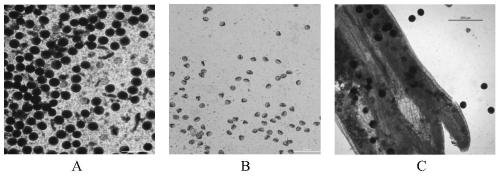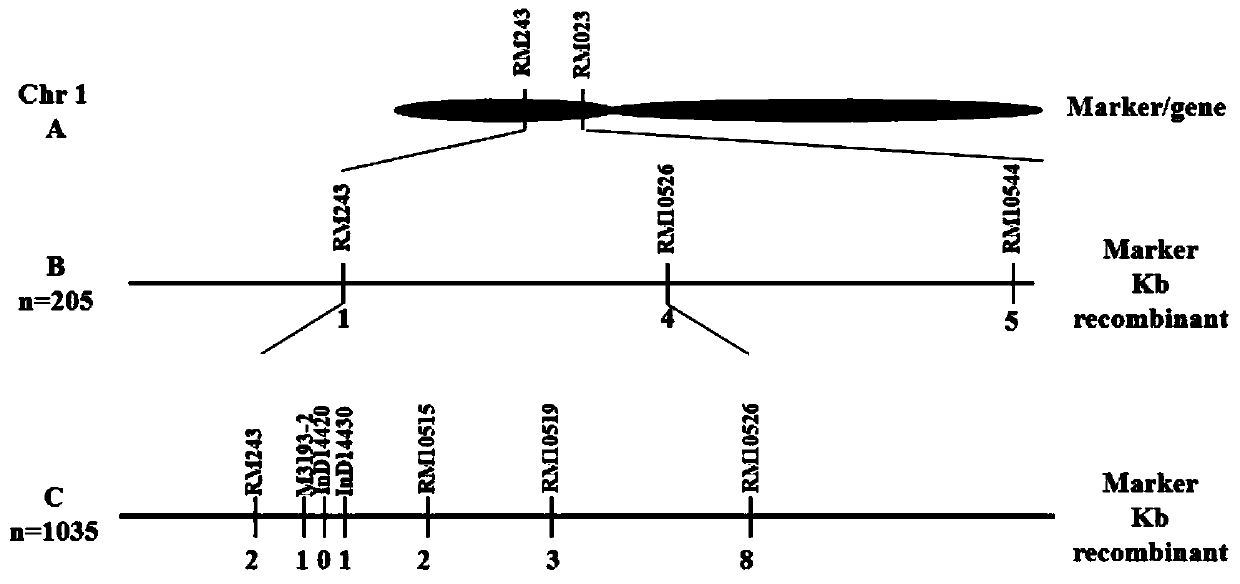Molecular marker related to photoperiod and thermo-sensitive genic male sterile phenotype of rice and application
A molecular marker and male sterility technology, applied in the field of plant molecular biology, can solve the problem of little understanding of the molecular basis, and achieve the effect of improving the efficiency of breeding
- Summary
- Abstract
- Description
- Claims
- Application Information
AI Technical Summary
Problems solved by technology
Method used
Image
Examples
Embodiment 1
[0043] Example 1 Phenotype and genetic analysis of rice photothermo-sensitive genic male sterile mutant tms3193
[0044] 1) Screening of tms3193 mutants
[0045] In June 2013, 10 kg of 93-11 seeds were irradiated with cobalt 60 to obtain the M0 generation. The irradiated seeds were planted in the experimental field in Lingao County, Hainan Province, and harvested by individual plants after maturity. A total of about 6,500 M1 generation materials were obtained. In the spring of 2014, 3617 M1 generation materials with a large amount of seeds were selected and planted into plant lines, each planting 50 individual plants. Various types of mutants such as plant type, ear type, fertility, yield, etc. were screened at the tillering stage, booting stage, heading stage, flowering stage, and filling stage, and harvested and stored. One mutant was found to be male sterile in the 3193 family, and was named tms3193.
[0046] 2) Phenotypic analysis of tms3193 mutant
[0047] Under the high seaso...
Embodiment 2
[0050] Example 2 Preliminary localization of TMS3193 photo-temperature-sensitive male sterility gene
[0051] Using bulked segregant analysis and recessive-class analysis to locate the TMS3193 gene. A F2 population was constructed by crossing Minghui 63 as the male parent with the tms3193 mutant, and 205 sterile plants were isolated. 301 pairs of SSR markers evenly distributed on 12 chromosomes were used to screen the markers with polymorphism between 93-11 and Minghui 63, and 64 pairs of SSR markers with polymorphism were obtained. The polymorphism was low, indicating that Hui 63 and 93-11 have little difference in genome sequence. A mixed gene pool of fertile plants and sterile plants of the F2 population is constructed separately, and the fertile gene pool and the sterile gene pool are analyzed using the 64 pairs of polymorphic markers. The results showed that SSR markers RM243 and RM023 on chromosome 1 were linked to the mutation phenotype of tms3193. The above-mentioned l...
Embodiment 3
[0052] Example 3 Fine Mapping of TMS3193 Photo-temperature Sensitive Male Sterility Gene in Rice
[0053] On the basis of the above coarse positioning results, a recessive-class analysis method is used for fine positioning. Using linkage markers to select tms3193 heterozygous individual plants in the F2 population developed an F3 population containing 3322 individual plants, of which 904 sterile plants were isolated. At the same time, 5 polymorphic markers were further developed between the markers RM243 and RM10526. Among them, the primer used to detect the molecular marker Indel14420 is shown in SEQ ID NO.1-2; the primer used to detect the molecular marker M3193-2 is shown in SEQ ID NO.3-5; the primer used to detect Indel14430 is shown in SEQ ID NO. IDNO.6-7 shown. Using these markers to detect the genotypes of the sterile plants isolated from the F3 population one by one, it was found that only one sterile plant had expanded 105bp and 111bp bands at the M3193-2 marker, while...
PUM
 Login to View More
Login to View More Abstract
Description
Claims
Application Information
 Login to View More
Login to View More - R&D
- Intellectual Property
- Life Sciences
- Materials
- Tech Scout
- Unparalleled Data Quality
- Higher Quality Content
- 60% Fewer Hallucinations
Browse by: Latest US Patents, China's latest patents, Technical Efficacy Thesaurus, Application Domain, Technology Topic, Popular Technical Reports.
© 2025 PatSnap. All rights reserved.Legal|Privacy policy|Modern Slavery Act Transparency Statement|Sitemap|About US| Contact US: help@patsnap.com



